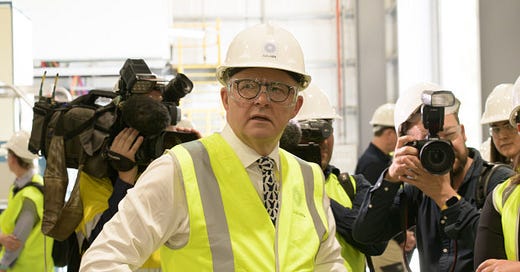PM must pick his winners with more care
The Prime Minister has never seen a hi-viz project he didn’t like. But industry policy must be far more discriminating in a labour-short economy
I’ve returned to the pages of the Australian Financial Review, after a very long absence.
The Albanese government’s Future Made in Australia policy, the centrepiece of the forthcoming Budget is part of a revival of industrial policy in the world. This revival reflects a global loss of faith in the idea that markets, and particularly financial markets, are always best judges of how resources of all kinds should be allocated.
Prime Minister Anthony Albanese in his preferred dress. Mike Richards
Thirty years ago, in the days of the Hawke-Keating government, every policy decision was followed by an anxious wait to see how “the markets” would react. In the wake of the GFC, and the absurdities of “meme stocks” and cryptocurrency, there is more sympathy for the view expressed by the great 20th century economist John Maynard Keynes: [https://www.afr.com/link/follow-20180101-p5dadf] “When the capital development of a country becomes a by-product of a casino, the job is likely to be ill-done”.
But with or without financial markets, the job of allocating resources remains to be done. The crucial problem here is that of opportunity cost. The more investment and skilled workers we allocate to one activity, the less is available for others.
Unfortunately, there isn’t much sign that Prime Minister Anthony Albanese appreciates this. He is an enthusiast for any project (coal mines, football stadiums, submarines) that “creates jobs”, particularly the kind of “real jobs” done by men in hi-viz vests. Yet as we all know, the country is desperately short of skilled trades workers and likely to remain so for years to come.
In these circumstances, every job created in a new industry is one left unfilled in another. The most obvious source of new workers is the housing industry, which is already failing to meet dire social needs.
How then, should we go about designing an industry policy that meets our needs as a society. The first requirement is to avoid nostalgia for the manufacturing economy of the 20th century.
Most people regret the rapid closure of our car industry, resulting largely from the vindictive politics of then-treasurer Joe Hockey. [https://www.afr.com/link/follow- 20180101-p541sf] But there is no serious prospect of restarting it.
Hockey only accelerated a process that had been going on for decades, beginning with the Button Car Plan of 1983. The Button plan allowed for a gradual consolidation and eventual winding down of the industry at a pace that mostly avoided large-scale job losses. By the time Hockey became treasurer, domestic manufacturers held only 15 per cent of the market.
A second factor guiding industry policy is the need to avoid excessive reliance on China, where the government has already shown its willingness to use trade as a weapon. But it’s equally important to remember that the US and Europe are building up their own industry, and that it is unwise to duplicate their efforts. Most obviously, solar PV manufacturing capacity is growing nearly everywhere, to the extent that demand will take some time to catch up.
The key phrase here is “friendshoring”. [https://www.afr.com/link/follow-20180101-p5d3n9] We should be looking for niches that the US and Europe won’t or can’t fill. Our big assets are our almost unlimited solar resource and our large deposits of lithium.
We should be looking first at ways to export solar electricity, either directly through high-voltage direct current or embodied in products like ammonia, hydrogen.
We have already made significant steps in extracting lithium from its naturally occurring ore (spodumene) and processing it into battery materials such as lithium hydroxide. The next logical step would be battery manufacture. Unfortunately, the logistics of production chains mean that this isn’t really an option as regards electric vehicles, but there may be some other niches that can be filled.
Another big opportunity, where public investment could play a key role is the production of “green steel” from directly reduced iron (DRI) using hydrogen. The big difficulty here is that the haematite iron ore we currently produce is suitable for traditional blast furnaces but not for DRI. We need either to shift to the production of higher quality magnetite (Fortescue’s Iron Bridge mine is a pioneer here) or join research efforts to produce DRI from lower quality ore.
The return of industry policy has been criticised by free-market advocates as one of “picking winners”. But picking winners is precisely what we need to do. There is always the risk of backing the wrong horse. But spreading bets across the entire field is a guaranteed way to lose.
Read my newsletter




all good but: 'I’ve returned to the pages of the Australian Financial Review, after a very long absence' - heed the advice of the Scots/Shakespeare when they say: ''He who sups with the Devil should have a long spoon"
On the topic of picking winners, what did you make of the billion-odd dollars being thrown at that quantum computer company?
I think it’s an extremely high-risk bet. Even if the technology can be made to work, the evidence that they will be practically useful is equivocal at best from what I’ve been able to glean.
I would go further and suggest the bet is being placed mostly because of the one known useful application - codebreaking - is one that gets people with security clearances very excited.
I think we could have done a lot better just giving the money to the ARC and NHMRC (for all of those organisations’ pathologies).